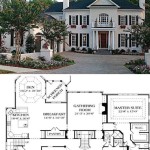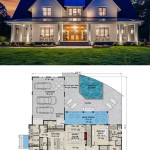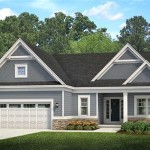Dream Homes With Floor Plans: Designing Your Ideal Living Space
The dream of owning a home is often accompanied by an equally vivid vision of its interior design. Floor plans are the blueprints that translate that vision into reality, guiding the construction and layout of your future living space. With the right floor plan, you can create a home that perfectly meets your lifestyle needs, aesthetic preferences, and family dynamics. This article explores the key elements of dream home floor plans, offering insights into how to design a functional and beautiful haven.
Understanding the Basics of Floor Plans
A floor plan is a scaled diagram that illustrates the layout of a building's interior. It shows the arrangement of rooms, walls, windows, doors, and other permanent fixtures. Essential elements of a floor plan include:
- Scale: The floor plan is drawn to scale, meaning that every inch on the plan represents a specific number of inches in the actual space. This allows architects and builders to accurately visualize and construct the home.
- Walls: Exterior and interior walls are depicted by their actual dimensions and locations. Walls can be made of various materials and often house electrical wiring, plumbing, and HVAC systems.
- Doors and Windows: Floor plans clearly indicate the size, placement, and type of doors and windows. These elements are crucial for natural light, airflow, and access to exterior spaces.
- Rooms: Each room is labeled according to its intended function - bedroom, kitchen, bathroom, etc. The size and shape of rooms are essential for determining furniture placement and overall functionality.
- Fixtures: Floor plans often include symbols for fixtures like sinks, toilets, appliances, and light fixtures. These indicate the placement and type of these essential elements.
Floor plans serve as a crucial guide for a variety of stakeholders throughout the construction process. Architects use them to design the layout, builders use them to construct the structure, and prospective homeowners use them to envision how their future home will feel and function.
Key Considerations for Dream Home Floor Plans
Designing a dream home floor plan requires careful consideration of several key factors:
1. Lifestyle and Family Dynamics
The ideal floor plan reflects your unique lifestyle and family needs. Consider:
- Family Size: How many bedrooms and bathrooms are necessary to accommodate your family? Are there specific needs for children, teenagers, or elderly members?
- Privacy and Communal Spaces: Do you desire separate spaces for work, relaxation, or entertaining? Do you seek a large open-plan living area or prefer more defined rooms?
- Lifestyle: Are you a homebody or a social butterfly? Are you passionate about cooking, gardening, or arts and crafts? The floor plan should support your desired activities.
- Future Flexibility: Consider your future needs. Will you require space for a home office, a guest room, or a growing family?
2. Functionality and Flow
A well-designed floor plan prioritizes functionality and ease of movement. Look for:
- Efficient Traffic Flow: Ensure that pathways through the home are wide enough and flow smoothly to prevent congestion in high-traffic areas.
- Accessibility: If needed, consider features that enhance accessibility for people with disabilities, such as wider doorways and ramps.
- Natural Light and Ventilation: Maximize natural light by strategically placing windows and doors. Consider ventilation for optimal air circulation and comfort.
- Storage Solutions: Plan for adequate storage throughout the home, including closets, cabinets, and pantries. A well-organized home feels more spacious and inviting.
3. Aesthetics and Personal Preferences
While functionality is critical, your dream home should also reflect your personal style and aesthetic preferences:
- Architectural Style: Consider the overall aesthetic of your home's exterior. Choose a floor plan that complements the style of the house (e.g., traditional, modern, farmhouse).
- Room Shapes and Sizes: Think about the shape and size of rooms. Do you prefer a formal dining room or a more casual eating area? Do you want a large master bedroom or a cozy guest room?
- Design Elements: Consider features that add visual interest, such as vaulted ceilings, open staircases, or unique windows and doors.
By carefully considering these factors and working with an architect or designer, you can create a dream home floor plan that seamlessly blends functionality, aesthetics, and personal preferences. With careful planning, your floor plan will not only define the structure of your home but also shape the way you live within it.

Dream House Plans Make Your Dreams Come True

5 Tips To Build Your Dream Home And Stay On Budget Dfd House Plans Blog

Mediterranean Dream Home Plan Italian Floor

Couple Finds Dream Home Plan The House Designers

1st Floor Image Of Luxury 5 Bedroom Mediterranean Style House Plan 8860 Plans Mansion

Creating Your Dream Custom Floor Plan Citadel Signature Homes

4 Bedroom Dream Home Plan With Bonus Expansion 25606ge Architectural Designs House Plans

Dream Homes Begin With A Floor Plan By David Weekley

View Plans House Floor How To Plan

One Y Dream Home Php 2024036 1s Pinoy House Plans








